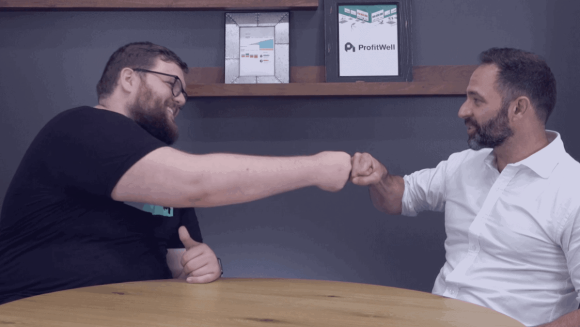Imagine: You sit down with your founding team and ask, “Who, specifically, are we building our product for, and why do they need it?” Will all your answers be the same?
More often than you might think, co-founders and early team members disagree on the answer to this seemingly simple—but extremely important—question. You may have different understandings of customer pain points. You might disagree on what makes your product unique. You could have different motivations for creating this product to begin with.
These things happen (especially in the early days). But if you don’t get your team on the same page, there will be trouble down the line. That’s where this product positioning exercise comes in.
What is product positioning?
“Positioning helps establish your product’s or service’s identity within the eyes of the purchaser.” –Entrepreneur.com
“Positioning defines where your product (item or service) stands in relation to others offering similar products and services in the marketplace as well as the mind of the consumer.” –The Economic Times
“Positioning is a brief description of a product or service and target market, and how the product or service fills a particular need of the target market.” –Hubspot
The definitions are endless, and none of these are wrong! At its simplest level, product positioning is the who, what, and why of your product.
- Who is it for?
- What specific features and benefits does your target audience need?
- Why are YOU unique in the market?
Positioning informs your external messaging and communication, and it helps you differentiate your product.
Let’s say you’re building a digital experience platform. There are so many platforms that fall into this category. What makes you different? You don’t want to be known as “just another one in the market.” Strong positioning helps your product stand out in all the best ways.
Aligning Your Team
I often find that early-stage founders have this information in their heads, but they haven’t taken the time to sit down with their team, discuss it, align around it, and document it in a clear, accessible way. This can be problematic for a few reasons.
- Team members can have different versions in their heads, which can cause messaging inconsistency and misalignment.
- Teams can grow quickly, and it can be hard for new team members to access this information if it’s not documented.
- When you’re moving at “a mile a minute” startup pace, it can be easy to lose sight of positioning and get off track.
That’s why formalizing and documenting positioning is so valuable. It helps align your team, protects against market confusion, and sets your startup up for success.
When should you start this product positioning exercise?
While there isn’t a final time to align stakeholders, there are three “signs” it might be time to get your founding team together, work through this product positioning exercise, and formally document it.
1. Does your product have its key features built (without major bugs)? If your product is about 80% built—meaning its core features are available—that’s an indicator that it can be tested with your target audience.
2. Have you been testing your product with your primary target audience? You might have more than one potential target audience, but focus on one to start with—find your minimum viable segment and test with that specific customer.
3. Are you confident that your product solves a problem for this audience segment? Based on feedback from your testing, you’ll likely have plenty of information to answer this.
If you can answer yes to these three questions, you should have enough information on hand to document and formalize your who, what, and why.
How to Document Your Product Positioning
You may have seen some version of this standard positioning statement template:
[For] <Add your target audience>
[Who] are looking for <add what they are looking to do/problem they are trying to solve>
[Product] <company name> is an <describe your business and what it does>
Unlike other solutions, <company name> <add a line around your key differentiators, at a high level>
Rather than jumping into this template, it can be valuable to start at a macro level and create a more detailed document with this product positioning exercise. As you do, think through the following categories:
Key Trends
Outline some of the key market trends that influence your product. For example, the fact that so many people are now working from home is a major trend that is likely influencing many product roadmaps.
- What trends are influencing your product?
- Why did you start building your product in the first place?
Company Mission
Include your mission at the beginning of your positioning document. Think through:
- Why do you even exist?
- What are you setting out to achieve?
Target Audience
This is the Who part of your positioning. Who is your ideal customer? If you’re B2B, list some of the ideal organizational characteristics that fit your target, such as company size and vertical. Then dive into the user persona, a fictional character that resembles your target audience. If you’re B2C, go right into identifying and defining the persona.
- Their demographic information (i.e. gender, age range, geography)
- Their background/role (B2B: Job Title; B2C: who are they)
- Their goals
- Their motivations
- Their frustrations
- Their influencers (B2B: manager, procurement officer, etc.)
Pain Points
This is one of the most crucial parts of a positioning document. Successful businesses and products solve a problem.
- What are those problems?
- What pain points does your specific persona have?
Key Competitors
You can do more in-depth competitive analysis after positioning work, but for this section, simply list your key competitors and include links to their websites.
Feature & Benefit
This is your What section. Think back to your user testing and outline the key features that you know your audience is looking for.
- What features help this persona?
Then get to the benefit by asking:
- Why does the customer need this feature?
- What specific value does it provide to them?
Key Differentiators
This is where your Why comes in. Put yourself in your customer’s shoes and think about what sets you apart.
- What do they like about the other products or solutions?
- What’s not working for them?
- If they could change something about those solutions, what would that be?
- Why are you unique from these other solutions in the market?
- Why would you buy from YOU?
Positioning Statement
Finally, it’s time to draft your positioning statement. Based on what you’ve reviewed in the sections above, keep it short, sweet, and simple.
[For] <Add your target audience>
[Who] are looking for <add what they are looking to do/problem they are trying to solve>
[Product] <company name> is a <describe your business and what it does>
Unlike other solutions, <company name> <add a line around your key differentiators, at a high level>
Here is an example with hypothetical information.
For marketers and demand generation leaders working at small businesses
Who are looking for an easier way to send out and measure their email marketing campaigns to their various audiences
XYZ company provides easy-to-use templates, segmentation tools, and dashboards to help streamline the entire email marketing workflow.
Unlike other solutions, XYZ company has 30 years of experience in the email marketing space and leverages AI technology to predict the success of each email campaign.
Testing Your Product Positioning
Now that you have a draft, the best way to measure your success is to test it out both internally with your team as well as externally with your target audience.
Start with your internal team. Send it out beyond your founding team to other members of the company, ask for feedback, and make any necessary edits.
- Is it consistent with their customer conversations?
- Does it make sense based on what they know?
- Is it consistent with the company’s direction to date?
After this, identify a set of customers—this could be the group you did initial testing with or advisors who know your business well. Ask for their input.
- Does this reflect your pain points?
- Does this seem authentic?
- Is this differentiated from other products in the market?
As you work through this entire process, remember to always come back to three key questions.
- Who is it for?
- What specific features and benefits does your target need?
- Why are YOU unique in the market?
And continually check that your team is aligned on all of their answers.
Again, while this product positioning exercise is a way to start, there is no real “end” to positioning work. To ensure your product development, messaging, and go-to-market strategy move in the right direction, revisit your positioning. That could be monthly, quarterly, or annually—depending on how much you’re testing, iterating, and pivoting. Market shifts happen, new competitors come into play, and pain points can change, so it’s crucial to revisit positioning at a regular cadence.












